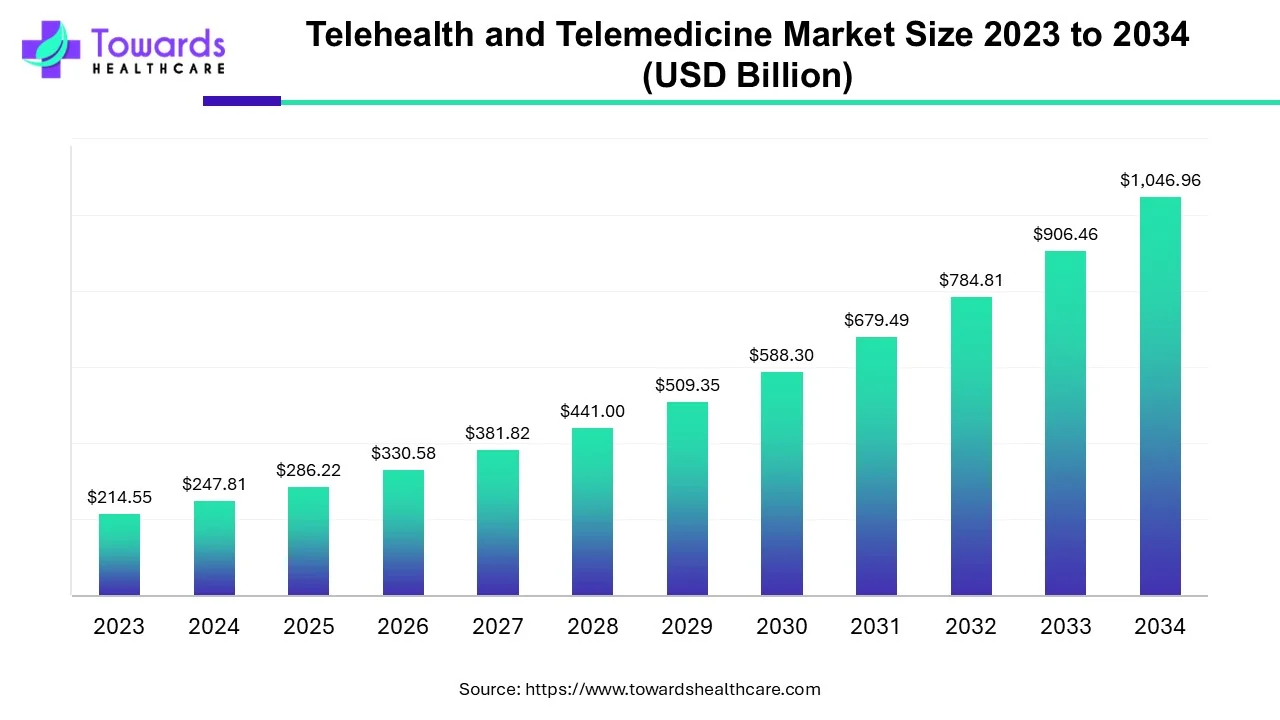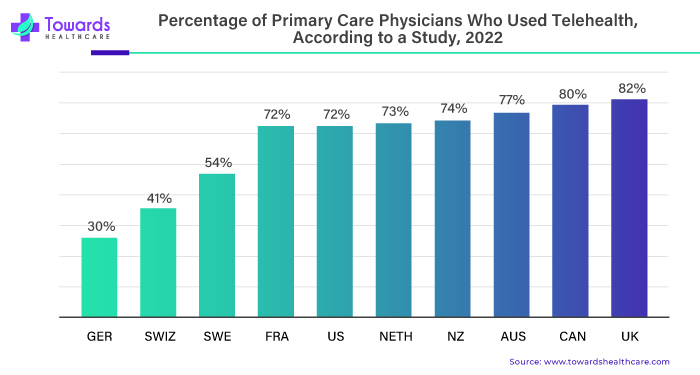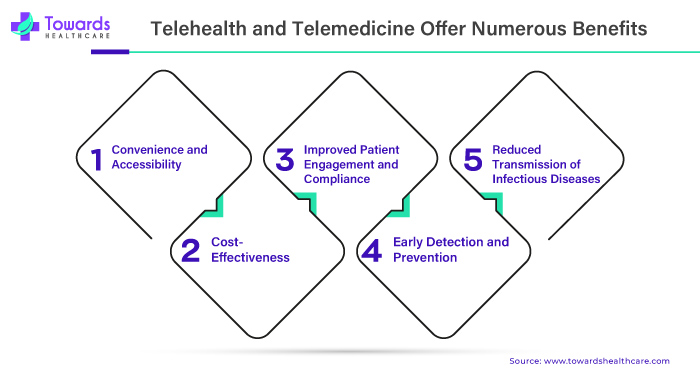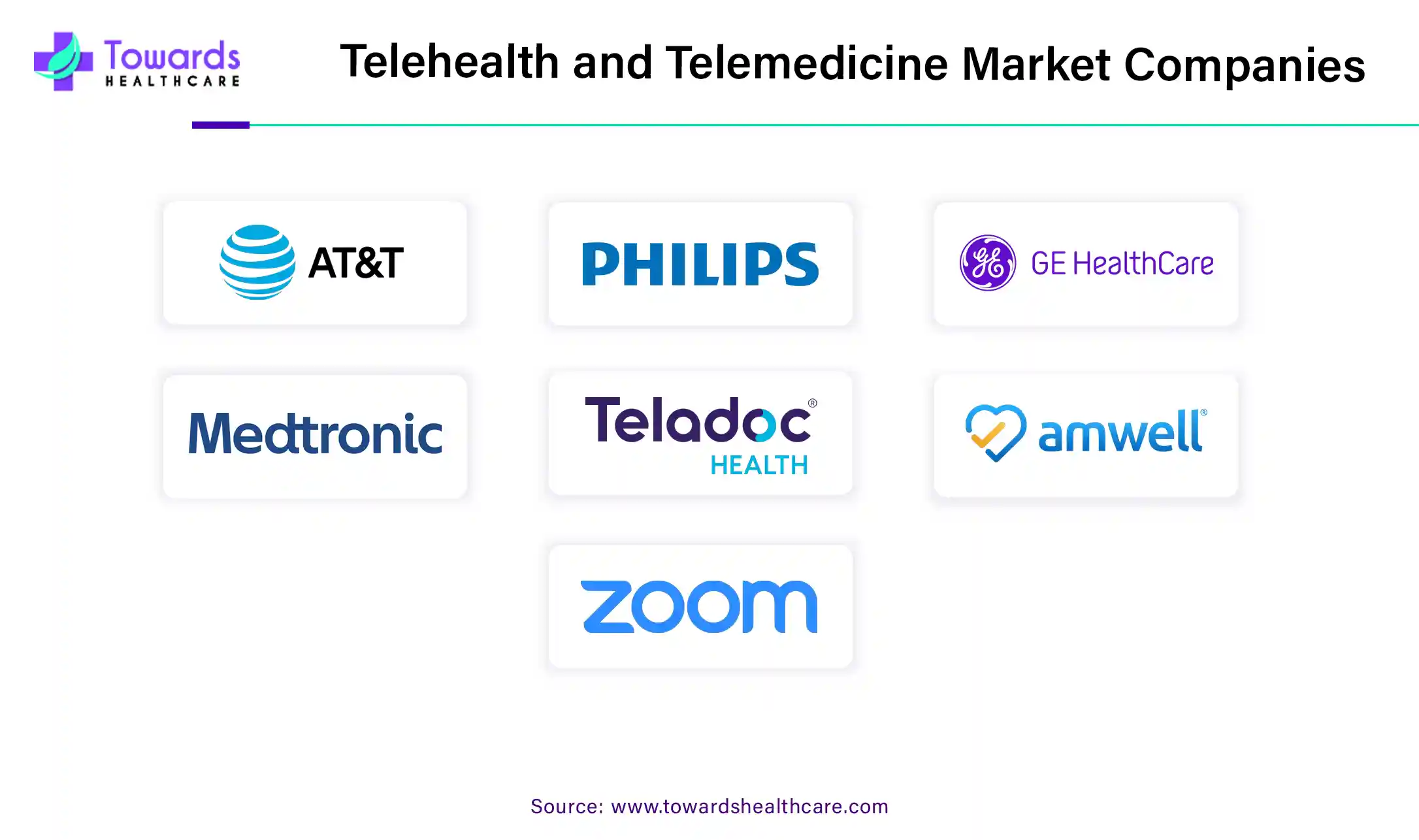March 2025

.webp)
Principal Consultant

Reviewed By
The telehealth and telemedicine market is anticipated to grow from USD 286.22 billion in 2025 to USD 1046.96 billion by 2034, with a compound annual growth rate (CAGR) of 15.5% during the forecast period from 2025 to 2034.

Understanding the growing demand for telemedicine, innovations in telehealth are on the rise, spurred by the significant uptake observed, as reported by the CDC, where 37.0% of adults have utilized telemedicine in 2021.
Telehealth and telemedicine are about using technology for healthcare from a distance. While they're similar, telehealth covers a broader range, including remote monitoring and education, while telemedicine focuses on clinical services like diagnosing and treating patients remotely.
The market for telehealth and telemedicine has grown a lot recently. Technology has improved, making it easier to connect remotely using the internet, smartphones, and wearable devices. People also want more remote care because of things like aging populations and chronic diseases, especially in areas where it's hard to get to a doctor's office. Plus, it's often cheaper than going in person, which is excellent for routine check-ups or managing ongoing health issues. The COVID-19 pandemic has pushed this even more. With the need to stay safe and avoid crowded places, healthcare providers turned to telehealth to keep treating patients.
The World Health Organization (WHO) forecasts a 10 million healthcare workers shortage by 2030. This need for healthcare professionals is expected to drive using artificial intelligence (AI) for treating and diagnosing patients. Telehealth provides healthcare services digitally and virtually to patients in distant areas.

Governments and regulators have also stepped in to support telehealth, making sure things like insurance cover it and that patient data stays safe. Many people, like doctors, tech companies, insurance companies, and patients, are involved in telehealth. There are platforms and software to help with virtual visits and monitoring patients, as well as devices like wearables that can track things like heart rate or blood sugar levels remotely.
The telehealth and telemedicine market is set to keep growing. As technology improves and rules more precise, more people will turn to these convenient and accessible ways to get healthcare. But there are still challenges, like ensuring everyone can access these services and securing patient information.
In addition, AR and VR in healthcare act as powerful allies to telehealth and telemedicine, enabling more immersive, interactive, and effective remote healthcare experiences. As these technologies continue to evolve, we can expect an even stronger synergy, ultimately transforming the future of healthcare delivery. Furthermore, the integration of health and wellness with telehealth and telemedicine, powered by technology like AR/VR, paves the way for a future where personalized, accessible, and engaging healthcare experiences are available to everyone.
Telemedicine is making a significant impact on healthcare delivery in several ways:
Overall, these findings suggest that telemedicine is transforming healthcare by making it more accessible, efficient, and cost-effective while improving the quality of care and strengthening relationships between patients and their doctors.

In February 2020, the CDC advised people and healthcare providers in areas affected by the COVID-19 pandemic. They suggested practicing social distancing, which means staying apart from others. Specifically, they recommended that healthcare facilities and providers use virtual methods like telehealth to offer clinical services instead of in-person visits.
For instance,
During the global COVID-19 pandemic, when a dangerous virus was spreading rapidly, people needed to be extra careful about going to places where they might catch it, like hospitals or doctor's offices. So, many turned to telehealth instead of going in person, which means getting healthcare through video or phone calls. This way, patients could still talk to their doctors and get advice or treatment without risking exposure to the virus.
Telehealth became important because it allowed doctors and patients to stay safe while still getting their needed care. It was like bringing the doctor's appointment to your home through your computer or phone. This way, patients didn't have to worry about going out and possibly getting sick, and doctors could still see and help their patients without being in the same room.
Because of this, telehealth has become more popular and used by more people than ever before. It showed how technology could be helpful during difficult times, like a pandemic, when staying safe and healthy is so important.
In 2023, HealthTap (US) introduced a new service called "HealthTap Circle," which operates on a subscription basis and provides personalized health coaching and access to support groups. Telemedicine platforms, like online doctor's offices, allow patients to have appointments with healthcare providers without needing to visit a physical clinic. These platforms streamline administrative tasks and connect patients with specialists who might be far away, improving access to specialized care for conditions like heart problems or mental health issues. They also engage patients more by offering tools like medication reminders and educational resources while ensuring that personal health information stays private and secure.
For instance,
Wearable devices, such as smartwatches or fitness trackers, are another essential part of telehealth. They can monitor vital signs like heart rate and activity levels in real-time, providing valuable insights into a person's health. For example, they can help manage chronic conditions by tracking symptoms and reminding patients to take their medications. Wearables empower patients to take control of their health by giving them personalized feedback and encouraging healthy lifestyle choices. Plus, when integrated with telemedicine platforms, these devices allow patients to share their health data with their healthcare providers during virtual appointments, helping doctors make more informed decisions about their care.
| Sr. No. | Indication | Launched Date | Device Details |
| 1. | General Health and Fitness |
January 2024 October 2023 |
|
| 2. | Chronic Condition Management |
October 2023 September 2023 |
|
| 3. | Mental Health and Wellbeing |
November 2023 November 2023 |
|
Advances in remote monitoring devices have revolutionized how patients manage their health and transform the healthcare landscape by extending the reach of telehealth beyond traditional clinical settings. By empowering patients to take an active role in monitoring their health at home and transmitting data to healthcare providers remotely, these devices have shifted the focus of healthcare from reactive to proactive management.
This proactive approach to healthcare is characterized by continuous monitoring and early intervention. It enables healthcare providers to detect subtle changes in patient's health parameters before they escalate into serious medical issues. For patients with chronic conditions such as hypertension, diabetes, or heart disease, remote monitoring devices offer a lifeline, providing reassurance and support in managing their conditions on a day-to-day basis.
Additionally, the seamless integration of remote monitoring data into telehealth platforms enhances care coordination and decision-making, enabling healthcare providers to deliver personalized, evidence-based interventions customized to each patient's needs. By leveraging real-time health data, healthcare teams can prioritize resources, optimize treatment plans, and intervene promptly when necessary, ultimately improving patient outcomes and quality of life.
Innovation drives market growth in telehealth and telemedicine by continuously expanding the scope of services, improving the user experience, and enhancing the efficacy of remote healthcare delivery. From AI-powered virtual assistants and remote diagnostic tools to virtual reality-based therapy and remote surgical interventions, ongoing advancements in technology and healthcare innovation are reshaping the future of telehealth.
For instance,
The convergence of remote monitoring devices and healthcare innovation is driving the expansion of telehealth and telemedicine, empowering patients, improving outcomes, and revolutionizing the delivery of healthcare services worldwide. As technology continues to evolve and new opportunities emerge, telehealth will play an increasingly central role in the future of healthcare, offering accessible, convenient, and practical solutions to meet the diverse needs of patients and providers alike.
Limited digital literacy among specific patient populations, especially older adults and individuals with lower socioeconomic status, presents a significant obstacle to effectively utilizing telehealth services. Digital literacy encompasses accessing, understanding, and effectively using digital technologies for navigating online platforms, communicating digitally, and accessing information and services. Several factors contribute to the challenges faced by these populations when engaging with telehealth platforms.
Older adults and those of lower socioeconomic status often lack access to reliable internet connectivity and digital devices like smartphones, tablets, or computers. These essential tools are necessary for them to participate in telehealth consultations or access digital health resources. Moreover, many individuals in these demographics need more familiarity with digital technologies and may feel intimidated or overwhelmed by telehealth platforms, deterring them from seeking such services.
Additionally, language and cultural barriers further complicate the use of telehealth platforms for specific populations. Individuals who primarily speak languages other than English may struggle to navigate platforms that are not available in their native language, leading to frustration and misunderstanding. Furthermore, health literacy is crucial in effective engagement with telehealth services. Individuals with limited health literacy may need help comprehending medical terminology, following complex instructions, or adhering to treatment plans recommended during telehealth consultations.
Targeted strategies are essential to address these challenges and ensure equitable access to telehealth services. These include offering digital literacy training programs explicitly personalized to older adults and individuals with lower socioeconomic status, empowering them with the necessary skills and confidence to navigate telehealth platforms effectively. Designing telehealth platforms with user-friendly interfaces, clear instructions, and intuitive navigation can also help lower the barrier to entry for individuals with limited digital literacy. Providing multilingual support and culturally sensitive resources can improve accessibility for diverse populations.
North America, particularly the United States and Canada, leads the global telehealth market in terms of market share and adoption. Factors driving growth in this region include:
Additionally, the COVID-19 pandemic has accelerated the adoption of telehealth in North America, leading to increased investment in digital health solutions and greater acceptance of remote care delivery.
Europe is experiencing rapid growth in the telehealth market, driven by factors such as aging populations, rising healthcare costs, and increasing demand for chronic disease management. Countries like the United Kingdom, Germany, and France are at the forefront of telehealth adoption, with initiatives to expand access to remote healthcare services and integrate telemedicine into existing healthcare systems.
The Asia-Pacific region is poised for significant growth in the telehealth market, driven by increasing smartphone penetration, expanding internet connectivity, rising healthcare expenditures, and a growing need for remote healthcare services in rural and underserved areas. Countries like China, India, Japan, and South Korea are investing in telehealth infrastructure and digital health initiatives to address healthcare access barriers and improve population health outcomes.

The competitive landscape for the telehealth and telemedicine market is dynamic and multifaceted, characterized by numerous players ranging from established healthcare providers to technology companies and startups. Traditional healthcare providers, including hospitals, clinics, and medical practices, increasingly integrate telehealth and telemedicine into their service offerings. These providers leverage telehealth platforms to offer patients virtual consultations, remote monitoring, and digital health services. Telemedicine services encompass various clinical specialties and healthcare disciplines, including primary care, specialty care, mental health, and chronic disease management. As telehealth adoption grows, insurers are expanding coverage for telehealth consultations, remote monitoring, and digital health services.

By Component
By Delivery Model
By Technology
By Application
By Geography
March 2025
March 2025
March 2025
March 2025